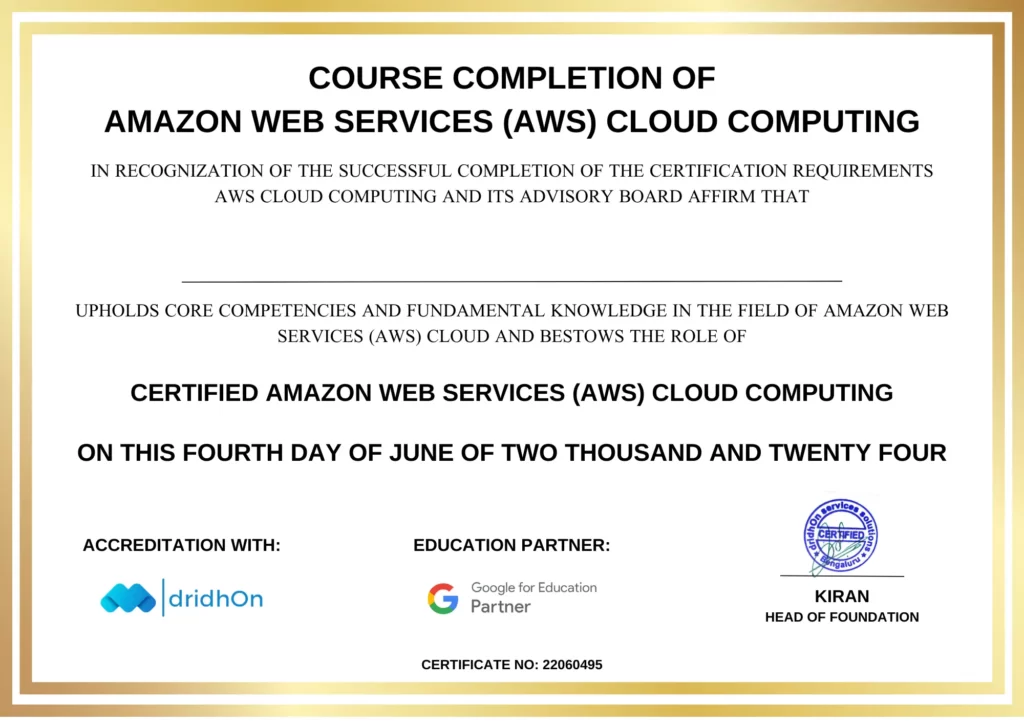AWS Mastery Training in Germany : Unleashing the Power of Amazon Web Services
Warm greetings to “AWS Mastery training in Germany ,” Your definitive guide to mastering Amazon Web Services. Whether you’re a beginner or an experienced professional, this course will provide you with the skills and knowledge you need to properly navigate and utilize AWS’s full potential.
- 5.0/5.0
- 1.2k Enrolled
- All Levels
- Last Updated
- English
Amazon Web Services - AWS Course Details
This course is thoroughly intended to equip you with a solid foundation in AWS, from the fundamentals to advanced topics such as Lambda, DynamoDB, and ECS, among others, allowing you to enthusiastically explode the cloud computing. This program in Germany is also designed to solve real-world projects of Amazon Web Services. AWS certification will be granted upon successful completion of the course.
Key Features
- Comprehensive Curriculum: A well-structured curriculum covering Cloud Computing & AWS, Load Balancing, Elastic Compute, S3, DevOps on AWS and so on.
- Hands-On training: Engage in real-world scenarios and hands-on projects to reinforce your understanding of AWS services.
- Expert Instructors: Learn from industry experts with extensive experience in AWS, who will guide you through every aspect in the field of amazon web services.
- Certification Preparation: Equip yourself for AWS certification with targeted modules and practice exams to ensure you are exam-ready.
- Flexible Learning: Access the course content at your own pace. Whether you're a full-time professional or a student, our flexible schedule adapts to your needs.
- Community Support: Join a vibrant community of learners. Participate in forums, discussions, and connect with peers for collaborative learning.
AWS Introduction Class
- 1.2k Enrolled
- Last Updated
- English
Skills Covered in Training
- Introduction to Cloud Computing & AWS
- Elastic Compute and Storage Volumes
- Load Balancing, Autoscaling and DNS
- Virtual Private Cloud
- Storage - Simple Storage Service (S3)
- Databases and In-Memory DataStores
- Management and Application Services
- AWS Migration
- DevOps on AWS
- Automation and Configuration management
Amazon Web Services (AWS) Course Certification Benefits
Due to its commercial benefits, including dependability and cost reduction, AWS (Amazon Web Services) has become a popular technology in industries such as banking, technology, telecom, and insurance. The worldwide AWS (Amazon Web Services) market is Clutch Market is forecast to reach $15.36 billion by 2025, after growing at a CAGR of 6.7% during 2020-2025 with more than 46580+ AWS Architect and Developer jobs available in Germany & around the world (source: Naukri, Indeed). A snapshot of hiring and package details is below.
AWS Packages year by Experience
AWS Cloud Engineer Fresher!
AWS Architects as a Fresher salary in India ranges between ₹ 2.4 Lakhs to ₹ 4.1 Lakhs with an average annual salary of ₹ 3.8 Lakhs. Salary estimates are based on 247 salaries received from AWS Solution Architect.
AWS Cloud Architect 2+ Years Experience!
AWS Cloud Professional Architects 2+ years of experience salary in India ranges between ₹ 4 Lakhs to ₹ 10.1 Lakhs with an average annual salary of ₹ 8.1 Lakhs. Salary estimates are based on 60 salaries received from AWS Professional Architect.
Senior Cloud Engineer More than 5+ Years Experience!
AWS Developer & Architects 5+ years of experience salary in India ranges between ₹ 7 Lakhs to ₹ 15.1 Lakhs with an average annual salary of ₹ 12.8 Lakhs. Salary estimates are based on 22 salaries received from AWS Developers & Architects.
Top Organizations that are Hiring for AWS Cloud Architect Developer
In India 2022-25, there are over 650000+ job vacancies for AWS Developers and solution Architects on LinkedIn, Naukri, and Monster.
AWS Developers & Solution Architects earn roughly INR 500000 per year on average, continuously hiring companies like AWS, HP, HCL, L&T, Accenture, Infosys, Bosch, IBM, Capgemini, Shell, Wipro, and Vega.
Amazon Web Services Careers: Consider a career as an AWS professional if you want to contribute to the battle against trending AWS Cloud Computing technology.
Amazon Web Services - AWS Course Syllabus in Germany
Who Should Enroll:
- IT Professionals seeking to enhance their cloud computing skills.
- Developers and System Administrators.
- Individuals preparing for AWS certification exams.
- Entrepreneurs and business owners exploring cloud solutions
AWS Course Content
Chapter 1: Introduction to Cloud Computing & AWS
What is Cloud Computing
Cloud Service & Deployment Models
How AWS is the leader in the cloud domain
Various cloud computing products offered by AWS
Introduction to AWS S3, EC2, VPC, EBS, ELB, AMI
AWS architecture and the AWS Management Console, virtualization in AWS (Xen hypervisor)
What is auto-scalingAWS EC2 best practices and cost involved
Chapter 2: Elastic Compute and Storage Volumes
- Introduction to EC2
- Regions & Availability Zones(AZs)
- Pre-EC2, EC2 instance types
- Comparing Public IP and Elastic IP
- Demonstrating how to launch an AWS EC2 instance
- Introduction to AMIs, Creating and Copying an AMI
- Introduction to EBS
- EBS volume types
- EBS Snapshots
- Introduction to EFS
- Instance tenancy- Reserved and Spot instances
- Pricing and Design Patterns
Chapter 3: Load Balancing, Autoscaling and DNS
- Introduction to Elastic Load Balancer
- Types of ELB – Classic, Network and Application
- Load balancer architecture
- Cross-zone load balancing
- Introduction to Auto Scaling, vertical and horizontal scaling, the
lifecycle of Auto Scaling - Components of Auto Scaling, scaling options and policy,
instance termination - Using load balancer with Auto Scaling
- Pre-Route 53 – how DNS works
- Routing policy, Route 53 terminologies, Pricing.
Chapter 4: Virtual Private Cloud - VPC
- What is Amazon VPC
- VPC as a networking layer for EC2,
- IP address and CIDR notations,
- Components of VPC – network interfaces, route tables, internet gateway, NAT,
- Security in VPC – security groups and NACL, types of VPC,
- What is a subnet, VPC peering with scenarios, VPC endpoints, VPC pricing and design patterns.
Join Us Today!
Are you ready to embark on your AWS journey?
Enroll now and gain the skills that will set you apart in the world of cloud computing.
Career Advice!
Feel Free to Contact Us or WhatsApp Us for Career Counseling!
- +91 9066508122
Frequently Asked Questions in AWS Certification Course!
Upon successful completion of the course, you’ll receive a certificate of achievement. Additionally, you’ll be well-prepared for various AWS certifications, which will open up new opportunities in your career.
1. What is the eligibility for this AWS training?
This program is especially designed for IT professionals, developers, system administrators, and anyone looking to enhance their skills in cloud computing with a focus on Amazon Web Services (AWS). It is suitable for freshers as well as those preparing for AWS certification exams.
2. What are the prerequisites for this training?
The course is designed to be completed in 10 weeks, but participants have lifetime access to the course materials. This flexibility allows individuals to learn at their own pace and revisit the content as required.
3. What is the duration of this course?
The course is designed to be completed in 10 weeks, but participants have lifetime access to the course materials. This flexibility allows individuals to learn at their own pace and revisit the content as required.
4. Will this training in Germany help me prepare for AWS certification exams?
Absolutely! The course includes specific modules dedicated to AWS certification preparation. Participants will have access to practice exams, quizzes, and guidance on AWS certification paths.
5. How can I enroll in the AWS training in Germany?
To enroll, simply visit our Contact Page or Call +91 9066508122 and follow the instructions. Seats are limited, so secure your spot early.
6. Are there any networking opportunities with fellow participants?
Yes, the course includes interactive elements such as discussion forums and collaborative projects, providing opportunities to connect with and learn from your peers.
7. How do I get technical support if I encounter issues during the course?
Our dedicated support team is available to assist you. You can reach out to them via email at mailto: info@dridhon.com for technical assistance.
Join the AWS Mastery training today:
Invest in Your Future with AWS Mastery – Your Gateway to Cloud Excellence!
Testimonials
What Our Students Say About Us
We don’t like to brag, but we don’t mind letting our students do it for us. Here are a few nice things folks have said about our themes over the years.
Key Features
Learning Experience
Here are just a few of the incredible benefits we were able to provide to our students.
1:1 Instructor Led Training
Live instructor-led instruction with a greater emphasis on real time projects
Industry Based Topics
Best Industry-specific curriculum crafted by experts which address real-world challenges effectively.
Real Time Projects
Individual will learn practical, hands-on training to help them apply what they've learned in real-world circumstances.
24/7 Placement Support
24x7 support clear up any conceptual ambiguities, seek learning help from mentors.
Interview Questions
Nail Job Interviews with Core Questions
Data Science Interview Questions
Data Science Interview Questions Data Science Interview Questions 1. What...
Read MoreTop 30 DevOps Interview Questions & Answers (2022 Update)
Top 30 DevOps Interview Questions & Answers (2022 Update) Top...
Read MoreAnti Money Laundering Interview Questions
Anti Money Laundering Interview Questions Anti Money Laundering Interview Questions...
Read MorePlacements
Placement Assistance to Get Hired Soon!
On course completion, we facilitate job interviews with reputable organizations and provide interview preparation to accelerate the launch of your career.
Web
"DridhOn Placement Portal: Uniting professionals and Candidates on a single platform for Career Success!"
Email Aletrs
Get an instant new job alerts by Logging in with your registered email or username on dridhOn Job Portals.
Call & WhatsApp
To speed up your job search, Set up personalized job alerts, manage your resume, apply online, and for more – call us
Amazon Web Services - AWS Course in Other Cities
Amazon Web Services - AWS Course in Other Countries
Error: Contact form not found.






















